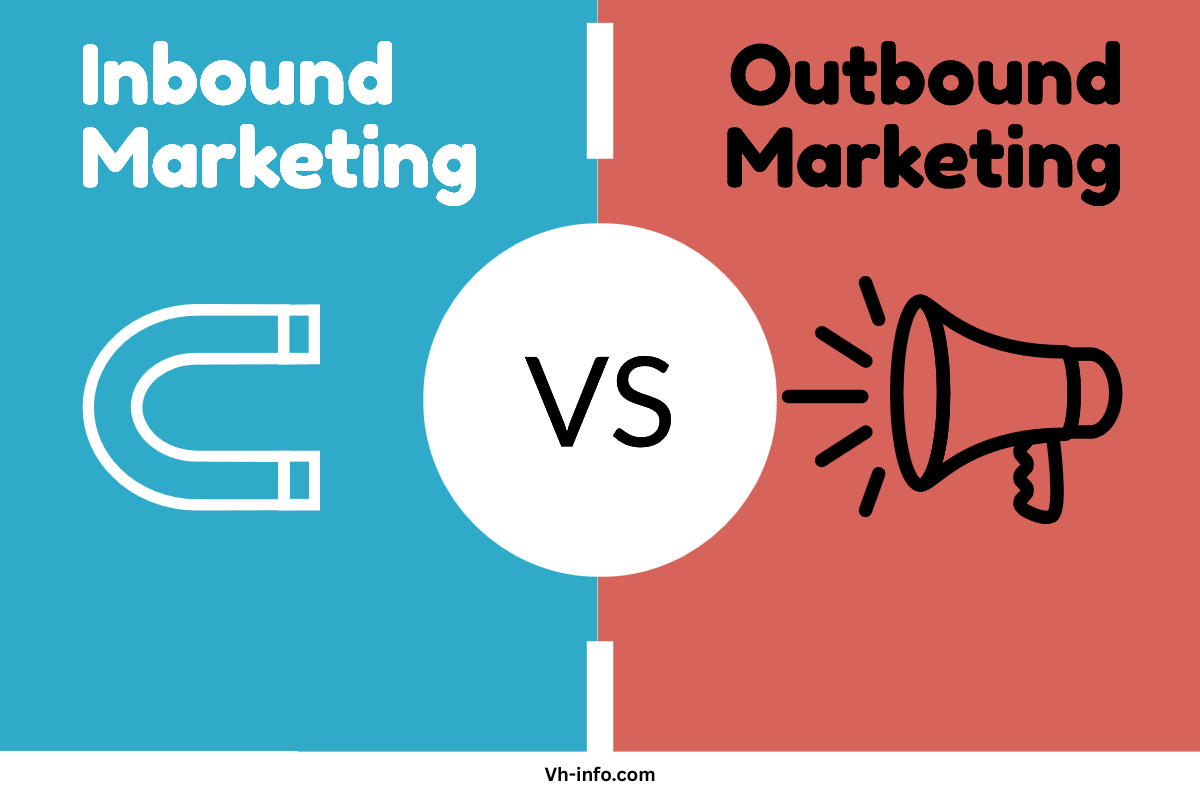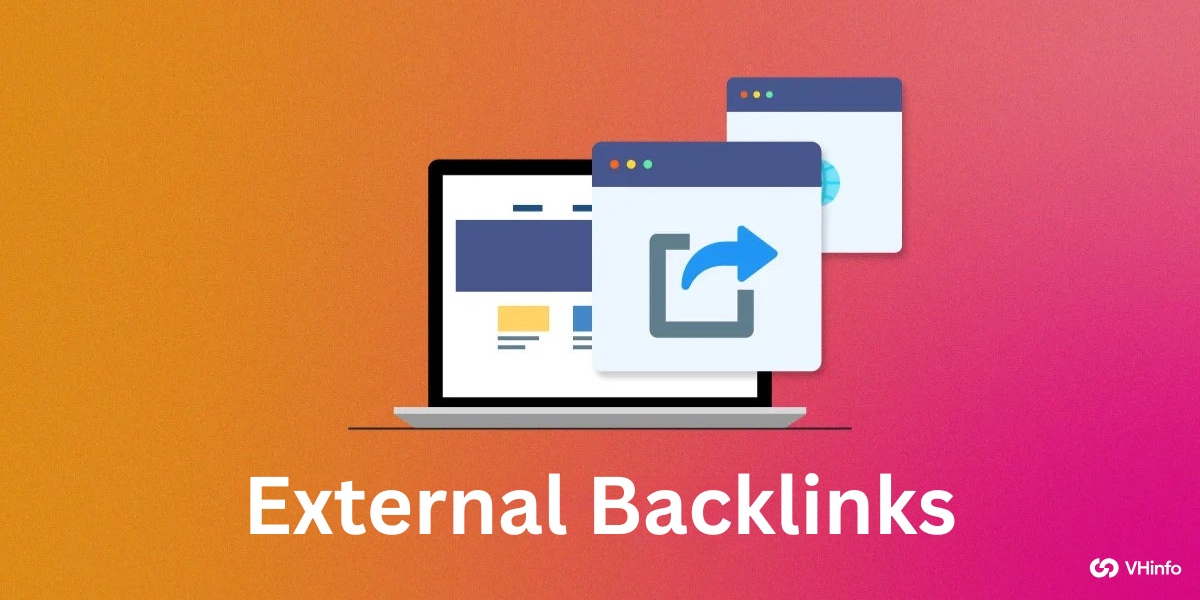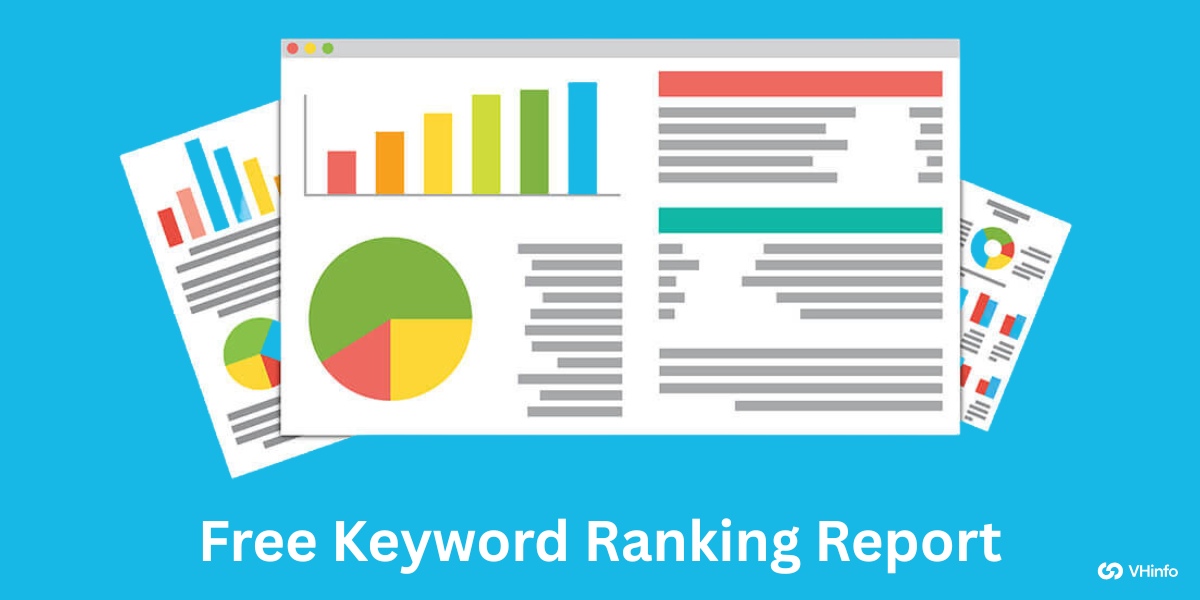The balance between inbound and outbound marketing can greatly impact your business growth. Both ways try to reach your target audience. However, they are different in method, cost, and results.
At VH-info, we have seen how the right marketing plan changes lead generation for SaaS firms. It also helps with customer acquisition efforts.
Inbound Vs Outbound Marketing
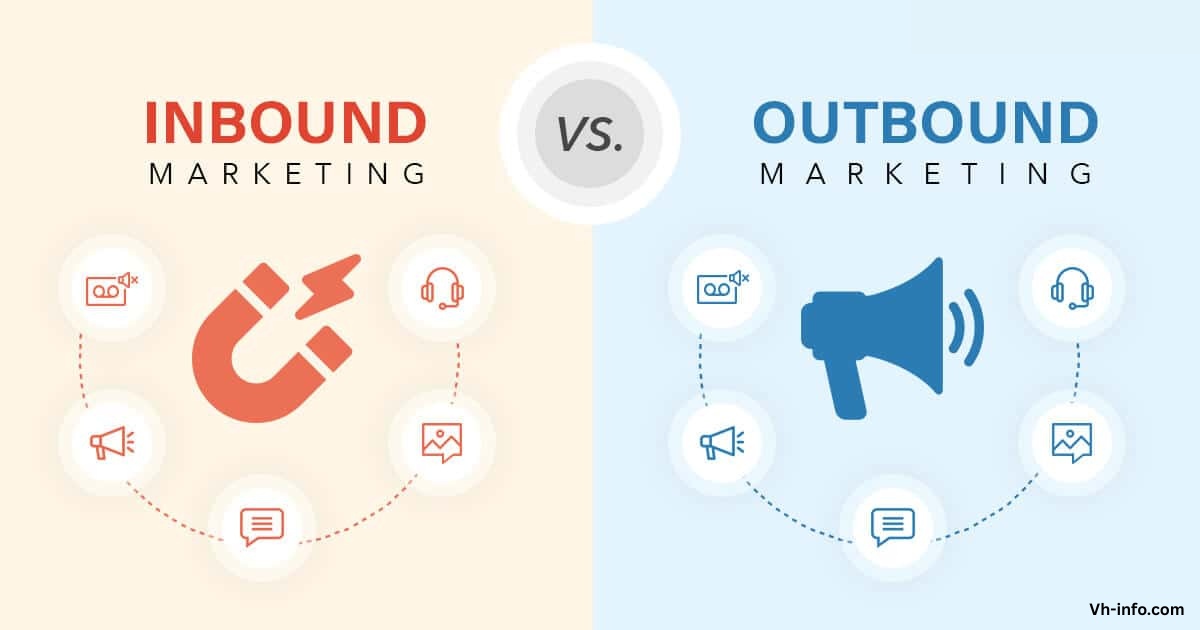
What Is Inbound Marketing?
Inbound marketing focuses on making useful content. This content attracts potential customers. Instead of pushing messages out, it pulls in prospects. It does this through helpful content, SEO, and social media. This method targets users who are looking for solutions.
By creating useful blog posts, videos, and other online materials, businesses build trust. They establish themselves as reliable sources in their field. When done correctly, inbound marketing brings leads over time. This happens long after the first piece of content is made.
What Is Outbound Marketing?
Outbound marketing is also known as “push marketing.” It tries to reach potential customers with your message. This method includes cold calls, direct mail, TV ads, radio ads, print ads, and trade shows.
Outbound marketing is different from inbound marketing strategies. It makes contact without knowing if people are interested first. This approach can create quick awareness. However, it needs ongoing money to keep visibility and results.
Key Differences Between Inbound and Outbound Marketing
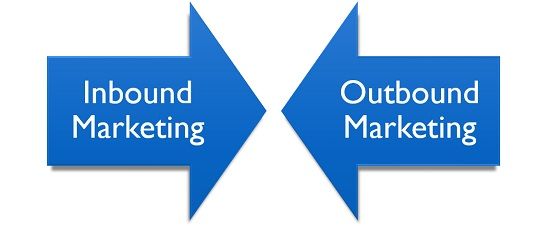
The key difference between these marketing strategies is their approach to customer engagement.
Inbound marketing attracts prospects with valuable content that meets their needs, earning attention organically through search engines and social media where audiences are active.
Conversely, outbound marketing pushes messages to a broader audience, seeking attention from potential customers who may not be actively looking for solutions.
While inbound builds relationships gradually, outbound creates immediate visibility but can disrupt customers’ routines.
Additionally, cost structures vary: outbound tactics require larger upfront investments in advertising and sales resources, whereas inbound strategies demand more time but often yield better long-term results as content continuously draws leads without extra costs.
Pros and Cons of Inbound Marketing

Pros:
Inbound marketing has many benefits for businesses that want to grow. It brings in good leads because customers find solutions themselves.
This results in higher conversion rates and better ties with customers. It is also cost-effective; while making good content costs money, the long-term benefits can be great. Inbound marketing helps build brand awareness and shows your company as a leader. Its growth potential is very helpful—adding more content can attract new customers without raising costs a lot.
Furthermore, inbound methods give useful data about what audiences like and how they behave. For SaaS companies, inbound marketing works well with longer sales times and the need for trust before buying.
At VH-info, we have helped many SaaS firms use smart inbound plans to boost their marketing efforts.
Cons:
Inbound marketing has many benefits, but it also has some challenges.
One main challenge is the time it takes to see results. Often, it can take months for results to show up.
Creating quality content regularly needs a lot of work and skill. If the content is not optimized well, it may not rank high on search engines. This can lessen its effect. The content market is crowded, so only great quality will get noticed.
Also, good inbound marketing needs knowledge of SEO and other tech tools like content systems and analytics. This can be hard for companies that do not have these skills on their team.
Pros and Cons of Outbound Marketing

Pros:
Outbound marketing helps you get quick visibility and impact. This makes it great for launching new products. It also works well for entering markets fast. Outbound methods create awareness quicker than inbound ways. This speed is key for campaigns that need to act fast.
Moreover, outbound plans can reach big audiences quickly. TV ads and radio spots are useful for certain business goals. These methods give you control over when and where your message appears. You can make sure your marketing shows at the right time and place.
Lastly, events like trade shows allow face-to-face talks. These talks help build strong relationships with key people, unlike just digital ways.
Cons:
The high cost of outbound marketing is a big drawback. TV, mail, and radio ads need large budgets.
These costs come with risky returns, creating stress for fast results. Many people do not like these ads anymore. They skip TV commercials, block online ads, and ignore cold calls. This pushed outbound methods to try harder to get noticed.
Also, there are limits when it comes to targeting with outbound strategies. Digital ads are better at reaching the right audience now. But old ways like print and radio still miss many ideal customers. This wastes money on marketing efforts.
Finally, outbound marketing gives fewer chances for people to engage or build connections. It mainly uses one-way communication and lacks the interaction found in inbound content.
Inbound Vs Outbound Marketing: Based On Audience Behaviour
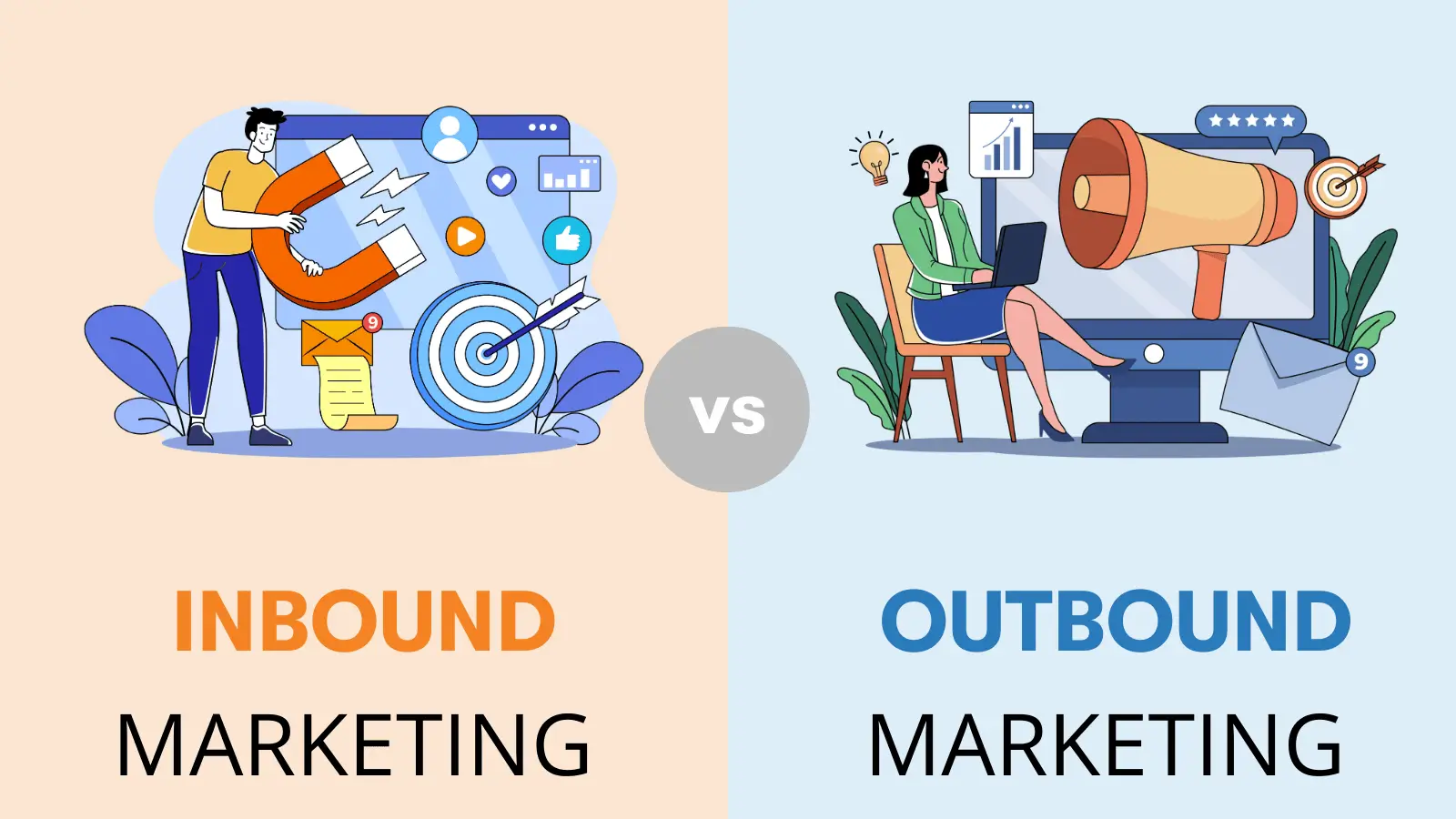
Outbound Marketing (Audience Behaviour)
Outbound marketing means that businesses contact possible customers, no matter how interested they are. The audience usually pays little attention. They may see ads while watching TV, checking mail, or answering calls. This leads to low engagement rates.
Since these ads interrupt their activities, they need strong content to grab attention fast. This content must show value right away. Responses to outbound marketing can be quick but not deep. People may react quickly or just ignore the ads.
This makes it hard to create strong customer bonds and brand loyalty with this method alone.
Inbound Marketing (Audience Behaviour)
Inbound marketing uses the actions of the audience.
When people search for answers, read articles, or use social media, they connect differently with businesses. These users usually have certain needs and are more open to your message. Their choice in how and when to engage helps build stronger ties.
Useful content brings them back for more visits, sign-ups, and further discovery.
As time goes on, these good interactions create trust and loyalty to the brand. This builds a loyal group of customers.
Inbound Vs Outbound Marketing: Based On Technology
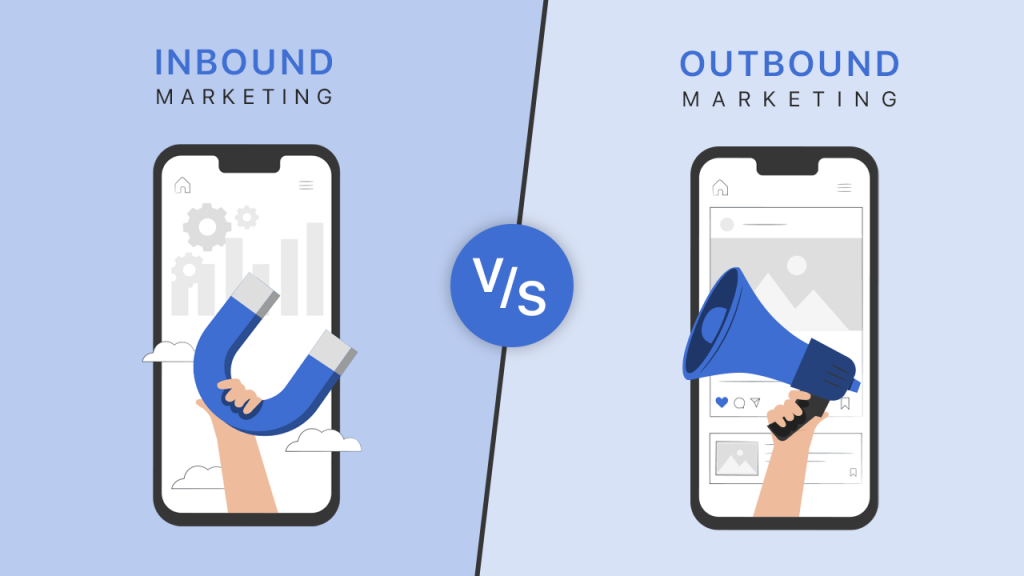
What Technologies Impact Inbound Marketing?
Inbound marketing uses digital tools for making, sharing, and measuring content. Content management systems help with easy publishing and control of online content. SEO tools make content easier to find. Social media sites help with sharing and getting people involved.
Marketing automation makes it more effective by guiding leads with tailored content paths. Analytics tools give details on how well things are working and how the audience acts for ongoing improvement. CRM systems keep track of talks all through the marketing process.
This gives a full picture of the customer path. Email marketing tools help inbound plans with automatic follow-ups and personal messages based on user actions. New tech in AI and machine learning is changing how we share content through smart insights and suggestions.
At VH-info, we have seen that using the right tech can greatly boost inbound marketing results for SaaS firms by creating smooth customer experiences.
What Technologies Impact Outbound Marketing?
Technology has changed outbound marketing. Customer data tools help target the right people. This reduces waste in large campaigns. Programmatic ads buy media automatically. This makes the process faster and better. Sales tools also help with cold calls and outreach.
They track results to see what works. Marketing systems keep messages the same across different channels. Analytics check how well each part is doing. Digital ads now have better targeting and real-time updates. They provide detailed performance data compared to older methods.
CRM systems track how prospects interact with brands. This creates a smooth experience, even with interruptive outbound tactics.
Inbound Vs Outbound Marketing Channels
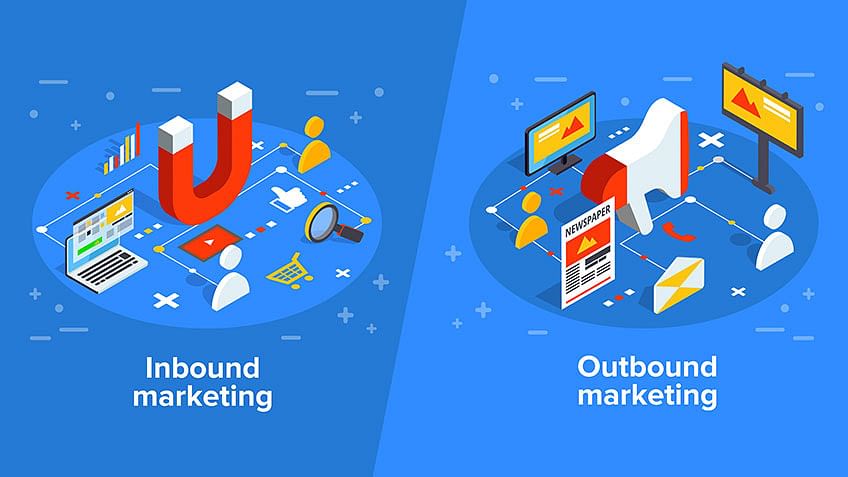
Key Channels Of Inbound Marketing
Web Content With Virality Factor
Content meant for wide sharing can significantly expand reach at no extra cost. Blog posts, infographics, and videos on trending topics or unique insights often gain organic traction through social sharing.
To create content with “virality potential,” understand what drives your audience to share. Successful viral content usually evokes strong emotions, presents surprising information, or delivers exceptional utility.
While virality isn’t guaranteed, analyzing successful industry examples can reveal patterns that enhance sharing chances. When it succeeds, viral content can lead to substantial visibility and valuable link-building opportunities, amplifying your inbound marketing efforts.
Web Content With Search-Ranking Factor
Search-engine-optimized content is vital for sustainable inbound marketing.
Blog articles, guides, and case studies targeting specific keywords ensure your business appears in relevant searches. Prioritize both search engine requirements and user value.
Effective content answers questions thoroughly, includes keywords naturally, and offers unique insights.
Additionally, technical factors like page speed, mobile responsiveness, and schema markup enhance visibility. When executed effectively, this content generates traffic and leads for years, delivering significant long-term value.
Social Media Posts, Hashtags, and Groups
Social media channels are strong for sharing content and connecting with people.
Each platform needs a special method. What works on LinkedIn may not work on Twitter or Instagram. Using hashtags can increase visibility. Joining the right groups can improve community presence. Success comes from giving value, not just promoting products.
By sharing helpful content, answering questions, and starting talks, businesses can grow a loyal audience. This audience helps boost inbound marketing efforts. Regularly checking engagement metrics helps to improve social strategies over time.
OOH and DOOH
Out-of-home (OOH) and digital out-of-home (DOOH) advertising typically fall under outbound marketing, but innovative strategies can include inbound elements.
By adding QR codes, memorable URLs, or social media handles to physical ads, businesses can connect offline and online experiences. This hybrid approach uses outbound channels to drive traffic to inbound resources, fostering a cohesive marketing ecosystem.
While initial exposure is outbound, engagement shifts to inbound as people seek more information online.
Key Channels Of Outbound Marketing
Broadcast Media
Television and radio ads still reach many people, even with changes in media.
They are great at creating quick awareness for products that many people want. The mix of sound and visuals makes strong impressions that text ads usually do not have. While using broadcast media needs a lot of money, placing ads in the right shows can make it work better.
For SaaS companies, broadcast ads might not seem like a good fit. However, specialized business shows can effectively reach key decision-makers when other options are full.
Digital Advertising
Paid search, display ads, social media ads, and video pre-rolls are new ways to do outbound marketing. These digital channels allow for precise targeting and measuring that old methods do not offer.
Programmatic ads improve placement by focusing on how well they work. The best part of digital ads is their flexibility and size.
Campaigns can start fast, test different options at the same time, and change based on live data. This quick adjustment makes digital ads good for short-term goals like getting leads and long-term goals like building brand awareness.
Exhibitions and Outdoor Events
Trade shows, conferences, and industry events provide valuable face-to-face interaction with potential customers.
These settings allow for product demonstrations, relationship building, and competitive intelligence gathering. The personal connections formed at events often accelerate the sales process, particularly for complex B2B solutions.
While the upfront costs of event participation are high, the quality of interactions can justify the investment. Strategic pre-show outreach and post-show follow-up maximize returns by creating touchpoints before and after the in-person connection.
Email Marketing (One To One)
Personalized emails to specific prospects are a direct form of outbound marketing. When these emails are based on research and fit the needs of the recipient, they can get much higher response rates than mass emails. This method works best for important B2B connections.
Good one-to-one email marketing needs careful research and clear value points. It also requires real personalization, not just adding the recipient’s name.
When done right, this targeted method links outbound and inbound ideas by starting relationships that matter and add value.
Email Marketing (One To Many)
Broadcast emails to bought or rented lists show a more old-fashioned outbound method. Open rates are usually low.
However, the large reach and low cost can make these campaigns useful for some goals. Success relies on the list quality, catchy subject lines, and clear actions for the reader.
To boost results, dividing the list by age, job, or other factors helps make emails more relevant. Testing different subject lines, content, and send times can also improve outcomes.
Even with these changes, companies should know that mass email is often just one part of a larger marketing plan.
What’s More Effective, Inbound Or Outbound Marketing?
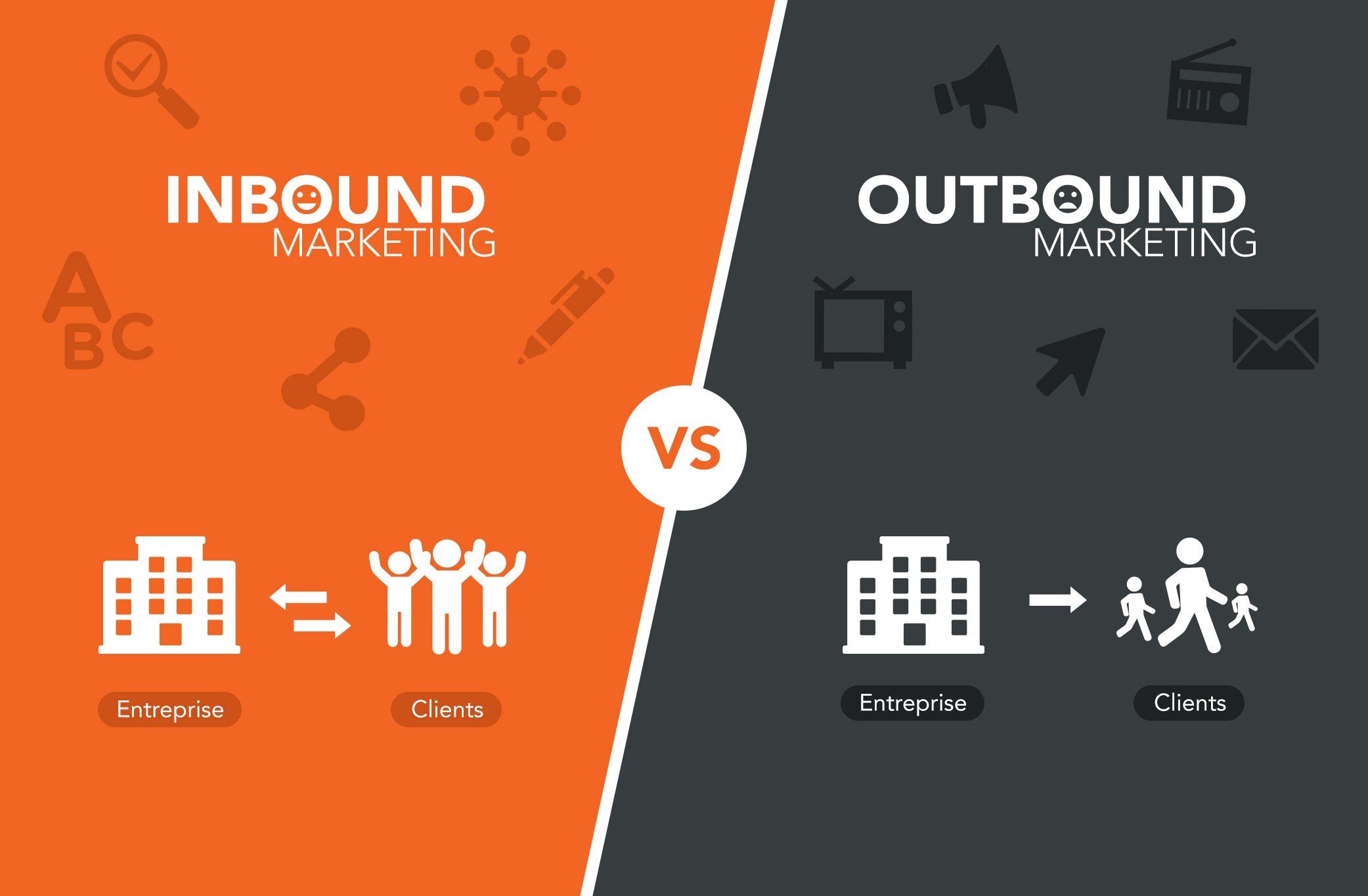
The success of inbound and outbound marketing depends on your business needs, goals, and tools. Inbound marketing often brings better leads at a lower cost. However, it takes time and requires steady content creation. These leads usually convert better because they are looking for solutions. On the other hand, outbound marketing gives faster results and more awareness. But it generally costs more per lead.
For new businesses that need quick visibility or firms launching products in crowded markets, this speed may be worth the price. The reliability of outbound also helps firms with strict growth goals. The best approach often uses both methods together.
Outbound tactics can improve inbound content, while inbound efforts can raise outbound lead conversions.
At VH-info, we see that SaaS companies get great results by mixing both strategies based on their marketing goals, sales cycles, and customer costs. The right mix changes as a company grows.
New startups may depend mostly on outbound to gain early traction before moving to inbound as they build their brand. Established companies often keep key inbound efforts while running focused outbound campaigns for certain goals.
Is Content Marketing Inbound Or Outbound Marketing?
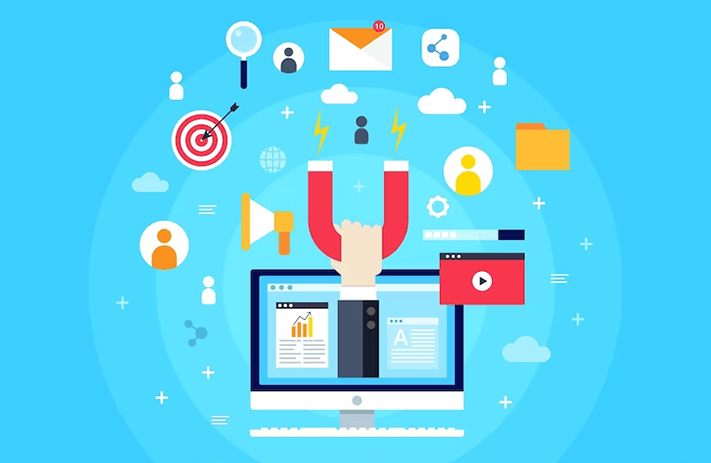
Content marketing follows inbound marketing rules. It creates and shares useful content to draw a specific audience. This is different from old outbound methods that disturb potential customers. Instead, it provides resources that people want, making your business look trusted.
The base includes blogs, videos, podcasts, and whitepapers. These attract people using search engines and social media. This method earns attention instead of buying it. This value helps build ties during the customer journey. Yet, sharing may use some outbound methods too.
For example, you can promote blog posts through paid social ads or boost videos using ads. This mixes inbound content with outbound reach.
When Content Marketing Becomes Outbound Marketing?
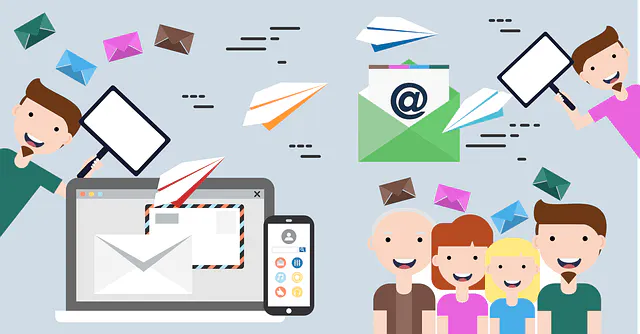
Content marketing becomes outbound when it pushes content instead of attracting audiences naturally.
Tactics like paid ads, content sharing, and sudden promotions focus on outbound methods. This often occurs when businesses get tired of slow growth. They then choose to use paid channels to gain quick visibility. However, this can change how the audience views the content.
Another problem happens when promotion takes over content quality. If resources focus more on sharing than creating useful information, the strategy looks like old-fashioned ads. The key difference is if the content meets audience needs or just business goals.
The best content programs mix inbound ideas (audience-focused, useful information) with smart outbound sharing. This helps increase reach while keeping content value and supporting business growth.
Can You Use Inbound And Outbound Marketing Together For Content Marketing?

Combining inbound and outbound approaches creates powerful synergies for content marketing. This integrated strategy uses the strengths of each approach while mitigating their individual weaknesses.
Here’s how they work together effectively:
Creating Engaging Content With Paid Promotion
High-quality content is essential for inbound marketing, but initial visibility often needs a boost.
Paid promotion via social media ads, sponsored content, and other outbound channels can quickly build your audience while your organic presence matures. As organic traffic increases, you can reduce or redirect paid efforts to new initiatives.
This strategy is especially beneficial for SaaS companies in competitive markets where organic visibility takes time. Ensure that promoted content provides real value rather than just selling products, upholding inbound principles even with outbound methods.
Using Influencer Marketing
Influencer partnerships combine inbound and outbound strategies by using established audiences. Collaborating with respected industry voices allows you to access their followers while maintaining content quality.
These relationships thrive when the influencer’s audience aligns with your target demographic, ensuring relevance.
Successful collaborations create co-branded content that benefits both audiences, respecting inbound principles by providing value while utilizing the influencer’s platform as an outbound channel to reach new customers.
Using Ads
Strategic advertising enhances inbound content by directing targeted traffic to valuable resources. Instead of promoting products, this approach highlights helpful content.
Retargeting campaigns nurture relationships with previous engagers, advancing them through the marketing funnel.
The most effective ads address specific pain points and position your content as the solution, maintaining the helpful spirit of inbound marketing while utilizing outbound channels.
Measurement should focus on not just clicks but also engagement with your content and movement toward conversion.
Using Inbound and Outbound Calling
For B2B SaaS companies, integrating calling strategies with content marketing creates a cohesive experience. Inbound calls from prospects who’ve engaged with your content receive personalized follow-up based on their specific interests.
Meanwhile, outbound calling becomes more effective when representatives reference relevant content during conversations.
This integration transforms cold calling into “warm calling” by providing representatives with insights about prospect interests and challenges.
When calls focus on understanding needs and recommending helpful resources rather than pushing immediate sales, they maintain the helpful spirit of inbound marketing despite using an outbound channel.
Analytics and Optimization
The true power of combining inbound and outbound approaches emerges through integrated analytics.
By tracking how prospects move between channels and content types, businesses can identify the most effective combinations for different segments. This data-driven approach continuously refines both content creation and distribution strategies.
Key metrics to monitor include channel-specific conversion rates, multi-touch attribution patterns, and content engagement across different audience sources. These insights help optimize resource allocation between inbound content development and outbound distribution channels.
The Future Of Inbound and Outbound Marketing
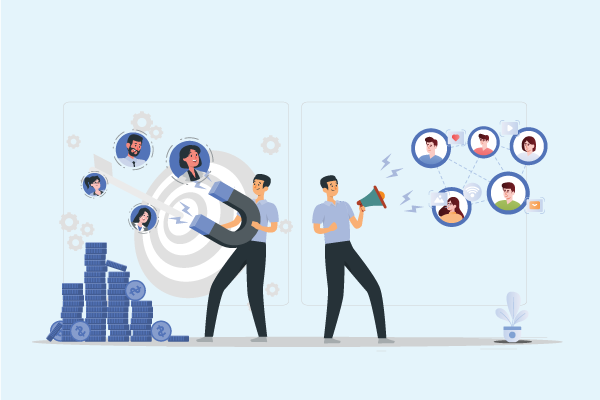
Technological Advancements:
Artificial intelligence and machine learning are revolutionizing inbound and outbound marketing.
For inbound, AI content optimization tools enhance relevance and search visibility, while predictive analytics pinpoint high-impact topics before creation. Automated personalization tailors content to individual user behavior.
In outbound marketing, AI improves targeting precision by identifying promising prospects through complex data patterns.
Automated outreach adapts based on recipient responses, fostering natural conversations. Voice recognition and natural language processing provide real-time guidance for representatives in phone-based outreach.
As these technologies evolve, the distinction between inbound and outbound will blur, leading to hyper-personalized experiences that seamlessly integrate proactive outreach with relevant content delivery.
Emerging Channels and Tactics:
Voice search optimization is a growing frontier in inbound marketing. With the rise of smart speakers and voice assistants, optimizing content for conversational queries is essential.
Similarly, visual search demands new strategies for image optimization and visual content creation.
For outbound marketing, interactive video and immersive experiences like augmented reality allow for active engagement with prospects, transforming traditional interruptive advertising into memorable participatory experiences.
Conversational marketing through chatbots and messaging platforms merges inbound and outbound strategies by facilitating proactive engagement alongside helpful resources.
These channels support both customer-initiated and business-initiated conversations, adapting to evolving user preferences.
Changing Consumer Behavior and Expectations:
Customers today demand personalization, relevance, and value in every interaction. Generic outbound messages struggle to capture attention, while superficial inbound content fails to meet information needs.
Future success hinges on understanding specific audience segments and developing sophisticated content. Privacy concerns are reshaping these strategies; as third-party data declines, first-party data from inbound channels becomes more valuable.
Outbound methods must prioritize permission and transparency while offering clear value.
A significant shift is toward community-centric approaches that foster connections among customers and prospects, creating ecosystems where value flows bidirectionally rather than solely from business to customer.
How LinkedIn Can Help Your Marketing?
LinkedIn has transformed from a networking site into a robust platform for inbound and outbound marketing. Its publishing feature allows businesses to share industry insights with professional audiences, while the algorithm prioritizes meaningful content over promotional material.
For outbound marketing, LinkedIn’s targeting options enable precise audience selection by job title, industry, and company size. Sponsored content and InMail facilitate direct access to decision-makers.
Additionally, the platform’s analytics provide insights into content performance and audience engagement, helping businesses refine their strategies based on what resonates most with their audience.
Inbound Or Outbound Marketing For Your Business? Which One To Choose?
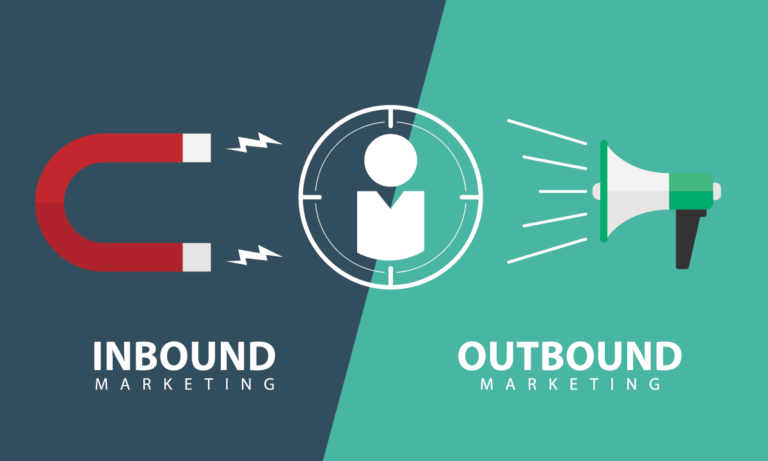
Choosing the right marketing plan needs a clear look at your business. Think about your situation, resources, and goals.
Start by checking your sales cycle. Complex processes do better with inbound marketing, which builds relationships. Simpler sales work better with direct outbound methods.
Next, consider where you stand in the market. New businesses may need visibility from outbound marketing.
In contrast, well-known brands can use their name through inbound content. The competition also plays a role. Crowded markets often need unique content to stand out. Resource limits are very important too.
Inbound marketing requires regular content and tech updates. Yet, it usually costs less for each lead in the long run.
Outbound methods need more money at first, but need less ongoing work for content. Most businesses succeed when they focus on one area only. Spreading resources too thin can end up with poor results.
For SaaS companies, a good plan mixes different methods based on goals and customer needs. Use targeted outbound tactics to raise awareness first. Then apply strong inbound resources during the decision stages.
This mix uses strengths while fixing each method’s problems effectively.
FAQ’s:
Can Small Businesses Benefit From Inbound Marketing?
Yes, small businesses often achieve great results with inbound marketing. Its lower cost per lead compared to traditional methods makes it ideal for limited budgets.
By targeting specific niches and creating relevant content, small businesses can effectively compete with larger competitors. Success hinges on starting with focused content that addresses customer needs rather than broad coverage.
Consistently publishing quality resources builds audience and authority over time. As results improve, the content program can expand into related topics based on performance data and feedback.
What Industries Still Use Outbound Marketing Successfully?
Several industries excel in outbound marketing. Financial services, especially for high-net-worth offerings, effectively use direct mail and personal outreach to target prospects. Healthcare tech companies leverage trade shows to showcase complex solutions to decision-makers.
B2B services with high contract values find outbound calling and direct email efficient, particularly with clearly defined territories or accounts. Manufacturing firms reach niche buyers through trade publications and industry directories.
The key to successful outbound marketing isn’t the industry but clear audience definition and tailored messaging. When businesses identify who needs their solutions and why, outbound strategies can yield strong returns, even amid a shift toward inbound methods.
How Long Does It Take To See Results From Inbound Marketing?
Inbound marketing typically takes 3-6 months to show significant results.
Initially, businesses focus on foundational content, SEO, and online presence. Traffic and leads may improve slowly at first. Growth usually accelerates around months 4-6 as content begins to rank and awareness increases.
By months 6-12, compounding effects lead to better performance of existing content and wider reach with new materials.
The full potential often unfolds after 12+ months of consistent effort. This timeline varies by industry competition, content quality, frequency, and brand authority; less competitive niches may see faster results.
Is It Necessary To Use Both Inbound and Outbound Marketing?
Integrated approaches often yield the best results, but businesses can succeed with either inbound or outbound marketing depending on their situation. Companies with limited resources should focus on one method.
The choice should align with the business model, target audience, and growth goals.
B2B companies targeting specific accounts may excel with outbound strategies that emphasize direct relationships, while information-heavy businesses may thrive using inbound methods. As complexity and competition grow, combining strategies becomes essential.
For mature organizations, integrated approaches are typically more effective for diverse customer acquisition and relationship management.
How Can I Measure The Success Of My Inbound Marketing Efforts?
Effective inbound marketing measurement involves tracking metrics throughout the customer journey, not just traffic or leads.
Start with content performance indicators like organic traffic growth, engagement metrics (time on page, bounce rate), and social shares to assess visibility and resonance. Then, monitor conversion metrics such as newsletter subscriptions, content downloads, and webinar registrations for deeper engagement. Evaluate lead quality through qualification rate, sales acceptance rate, and conversion-to-opportunity metrics to ensure you attract suitable prospects.
Finally, analyze business impact using inbound customer acquisition cost, conversion rates by content source, and customer lifetime value by acquisition channel to determine the true ROI of your programs.
Conclusion
Choosing between inbound and outbound marketing is not a simple choice. Both methods have valuable benefits. These benefits work best when they match business goals and customer needs. Inbound marketing helps with steady growth. It does this by using useful content and building real relationships. Outbound marketing provides quick visibility and direct responses from customers.
For SaaS companies, the best plan starts with inbound content. This content should solve customer problems and encourage organic discovery. It also helps start sales talks.
Next, smart outbound efforts can boost important messages to reach high-value groups quickly. As technology changes, the marketing world mixes old ways. Success today depends on making smooth experiences across different channels. It is no longer about keeping methods separate.
By delivering value at every stage—initiated by either customers or businesses—companies can build stronger connections and achieve sustainable growth. At VH-info, we assist SaaS companies in developing integrated marketing strategies that use both inbound and outbound techniques. Our expertise in SaaS link building establishes a solid foundation for effective inbound programs, and our guides aid clients in aligning their approaches to fulfill particular business objectives.
